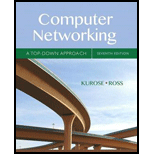
Computer Networking: A Top-Down Approach (7th Edition)
7th Edition
ISBN: 9780133594140
Author: James Kurose, Keith Ross
Publisher: PEARSON
expand_more
expand_more
format_list_bulleted
Question
Chapter 4, Problem R17RQ
Program Plan Intro
Host:
- A host is a computer system or any device connected to other system or device in a network to exchange the data.
- A network host provides required information or data resources, services, applications and many others to other users present in the network.
- It can be a network node related to the network address.
Internet Protocol:
Internet protocol is a process or protocol in which data is transferred between the computer systems through internet. Each computer system has its own IP address to send or receive the required data. It consists of five different layers namely, application layer, transport layer, network layer, link layer and physical layer.
Datagram:
- In networking, a datagram is a transferring unit which is used to transfer the data from a source to the destination and it doesn’t provide guaranteed service.
- It includes fragmentation process which is defined as the division of the data packet into small one when the data packets are larger than the maximum length of a particular system.
Transmission Control Protocol (TCP):
- TCP is an internet protocol used for exchanging of data between the sender and the receiver. It is a secured protocol for transferring the data.
- When the sender sends data to the receiver, he/she waits for the acknowledgement from the receiver.
- If acknowledgement is received then the next data packet will be sent and the process continues till all the data packets are sent.
- If acknowledgement is not received then the receiver is assumed as hacker or intruder and the connection will be removed.
User Datagram Protocol (UDP):
- User datagram protocol is a connectionless protocol.
- The protocols used in UDP cannot establish the connection for data communication.
- It is one of the communication protocol suites used for transferring small messages termed as datagram.
- Alternative for TCP is UDP, but the data transfer speed of UDP is higher than TCP because there is no acknowledgment and error-checking.
- Checksum and port number are the two services provided by the UDP.
- There is no guarantee for data delivery and duplication of data.
- It doesn’t provide a reliable service.
Network Layer:
Network layer is provides the path in which the data packets are transferred from the source to the destination. It also helps in converting the logical or IP address to physical or Media Access Control (MAC) address.
Expert Solution & Answer
Trending nowThis is a popular solution!

Chapter 4 Solutions
Computer Networking: A Top-Down Approach (7th Edition)
Ch. 4 - Lets review some of the terminology used in this...Ch. 4 - Prob. R2RQCh. 4 - Prob. R3RQCh. 4 - Prob. R4RQCh. 4 - Prob. R5RQCh. 4 - Prob. R6RQCh. 4 - Prob. R7RQCh. 4 - Prob. R8RQCh. 4 - Prob. R9RQCh. 4 - Prob. R10RQ
Ch. 4 - Prob. R11RQCh. 4 - Prob. R12RQCh. 4 - Prob. R13RQCh. 4 - Prob. R14RQCh. 4 - Prob. R15RQCh. 4 - Prob. R16RQCh. 4 - Prob. R17RQCh. 4 - Prob. R18RQCh. 4 - Prob. R19RQCh. 4 - Prob. R20RQCh. 4 - Prob. R21RQCh. 4 - Prob. R22RQCh. 4 - Prob. R23RQCh. 4 - Prob. R24RQCh. 4 - Prob. R25RQCh. 4 - Prob. R26RQCh. 4 - Prob. R27RQCh. 4 - Prob. R28RQCh. 4 - Prob. R29RQCh. 4 - Prob. R30RQCh. 4 - Prob. R31RQCh. 4 - Prob. R32RQCh. 4 - Prob. R33RQCh. 4 - Prob. R34RQCh. 4 - Prob. R35RQCh. 4 - Prob. P1PCh. 4 - Prob. P2PCh. 4 - Prob. P3PCh. 4 - Consider a datagram network using 32-bit host...Ch. 4 - Consider a datagram network using 8-bit host...Ch. 4 - Consider a datagram network using 8-bit host...Ch. 4 - Prob. P8PCh. 4 - Prob. P9PCh. 4 - Prob. P10PCh. 4 - Prob. P11PCh. 4 - Prob. P12PCh. 4 - Consider sending a 2400-byte datagram into a link...Ch. 4 - Prob. P15PCh. 4 - Prob. P16PCh. 4 - Prob. P17PCh. 4 - Prob. P18PCh. 4 - Prob. P19PCh. 4 - Prob. P20PCh. 4 - Prob. P21PCh. 4 - Prob. P22P
Knowledge Booster
Recommended textbooks for you
 Computer Networking: A Top-Down Approach (7th Edi...Computer EngineeringISBN:9780133594140Author:James Kurose, Keith RossPublisher:PEARSON
Computer Networking: A Top-Down Approach (7th Edi...Computer EngineeringISBN:9780133594140Author:James Kurose, Keith RossPublisher:PEARSON Computer Organization and Design MIPS Edition, Fi...Computer EngineeringISBN:9780124077263Author:David A. Patterson, John L. HennessyPublisher:Elsevier Science
Computer Organization and Design MIPS Edition, Fi...Computer EngineeringISBN:9780124077263Author:David A. Patterson, John L. HennessyPublisher:Elsevier Science Network+ Guide to Networks (MindTap Course List)Computer EngineeringISBN:9781337569330Author:Jill West, Tamara Dean, Jean AndrewsPublisher:Cengage Learning
Network+ Guide to Networks (MindTap Course List)Computer EngineeringISBN:9781337569330Author:Jill West, Tamara Dean, Jean AndrewsPublisher:Cengage Learning Concepts of Database ManagementComputer EngineeringISBN:9781337093422Author:Joy L. Starks, Philip J. Pratt, Mary Z. LastPublisher:Cengage Learning
Concepts of Database ManagementComputer EngineeringISBN:9781337093422Author:Joy L. Starks, Philip J. Pratt, Mary Z. LastPublisher:Cengage Learning Prelude to ProgrammingComputer EngineeringISBN:9780133750423Author:VENIT, StewartPublisher:Pearson Education
Prelude to ProgrammingComputer EngineeringISBN:9780133750423Author:VENIT, StewartPublisher:Pearson Education Sc Business Data Communications and Networking, T...Computer EngineeringISBN:9781119368830Author:FITZGERALDPublisher:WILEY
Sc Business Data Communications and Networking, T...Computer EngineeringISBN:9781119368830Author:FITZGERALDPublisher:WILEY

Computer Networking: A Top-Down Approach (7th Edi...
Computer Engineering
ISBN:9780133594140
Author:James Kurose, Keith Ross
Publisher:PEARSON

Computer Organization and Design MIPS Edition, Fi...
Computer Engineering
ISBN:9780124077263
Author:David A. Patterson, John L. Hennessy
Publisher:Elsevier Science

Network+ Guide to Networks (MindTap Course List)
Computer Engineering
ISBN:9781337569330
Author:Jill West, Tamara Dean, Jean Andrews
Publisher:Cengage Learning

Concepts of Database Management
Computer Engineering
ISBN:9781337093422
Author:Joy L. Starks, Philip J. Pratt, Mary Z. Last
Publisher:Cengage Learning

Prelude to Programming
Computer Engineering
ISBN:9780133750423
Author:VENIT, Stewart
Publisher:Pearson Education

Sc Business Data Communications and Networking, T...
Computer Engineering
ISBN:9781119368830
Author:FITZGERALD
Publisher:WILEY